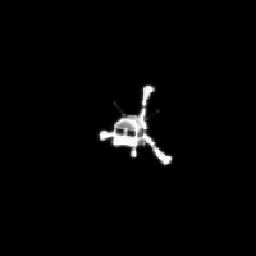
Click the image to play full resolution animation
This five-frame animated sequence from the European Space Agency's Rosetta orbiter shows the Rosetta mission's Philae lander descending toward comet 67P/Churyumov-Gerasimenko (not in frame) after the lander was released by the orbiter on Nov. 12, 2014.
Rosetta's Onboard Scientific Imaging System (OSIRIS) narrow-angle camera witnessed Philae's descent. This animation comprises images captured between 10:24 and 14:24 UTC (2:24 a.m. and 6:24 a.m. PST), onboard spacecraft time. Separation occurred onboard the spacecraft at 08:35 UTC (1:35 a.m. PST), with the confirmation signal arriving on Earth at 09:03 UTC (2:03 a.m. PST). The signal confirming landing arrived on Earth at 16:03 UTC (8:03 a.m. PST).
Rosetta is a European Space Agency mission with contributions from its member states and NASA. Rosetta's Philae lander is provided by a consortium led by the German Aerospace Center, Cologne; Max Planck Institute for Solar System Research, Gottingen; French National Space Agency, Paris; and the Italian Space Agency, Rome. NASA's Jet Propulsion Laboratory, a division of the California Institute of Technology, Pasadena, manages the U.S. participation in the Rosetta mission for NASA's Science Mission Directorate in Washington. Rosetta carries three NASA instruments in its 21-instrument payload.
OSIRIS was built by a consortium led by the Max Planck Institute for Solar System Research in collaboration with the Center for Studies and Activities in Space, University of Padua, Italy; the Astrophysics Laboratory, Marseille, France; the Institute of Astrophysics of Andalucia, Spain; the Scientific Support Office of the European Space Agency, the Netherlands; the National Institute for Aerospace Technology, Torrejon de Ardoz, Spain; the Technical University of Madrid, Spain; the Department of Physics and Astronomy of Uppsala University, Sweden; and the Institute of Computer and Network Engineering of the Technical University, Braunschweig, Germany. OSIRIS was financially supported by the national funding agencies of the German Space Agency, Cologne; National Centre for Space Studies, Paris, France; Italian Space Agency, Rome; Ministry of Education and Science, Madrid, Spain; the Swedish National Space Board, Solna, Sweden; and the European Space Agency Technical Directorate, Paris.
For more information on the U.S. instruments aboard Rosetta, visit http://rosetta.jpl.nasa.gov.
More information about Rosetta is available at http://www.esa.int/rosetta.
For publicly released image use, see ESA's Copyright Notice Images.

